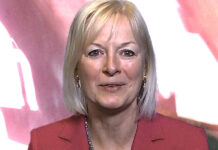Chris Perryman combines the brains to integrate quant strategies with the brawn of strong relationships ensuring PineBridge delivers best execution for investors.
Biography: Chris Perryman joined PineBridge Investments in 2009 and is corporate portfolio manager and head of trading, emerging markets (EM) fixed income. He is responsible for managing EM strategies and overseeing all aspects of EM fixed income and FX trading, including cash bonds, currencies, and derivatives. He was previously an emerging markets trader at Standard Bank’s fund management division, dealing with hard and local currency bonds, FX, and credit default swaps (CDS). Prior to that, Perryman served as a credit team’s portfolio analyst at Morley Fund Management and before that worked at the London Stock Exchange. He holds an Investment Management Certificate and a Diploma in Technical Analysis from the Society of Technical Analysts.
How is your trading team set up?
Day-to-day trading is done by pure traders. As head of trading my role is one of oversight and looking forward, I am always planning five years ahead. Right now we are looking at shorter term projects that we can solve in-house, with longer term trends that may need technology or other solutions.
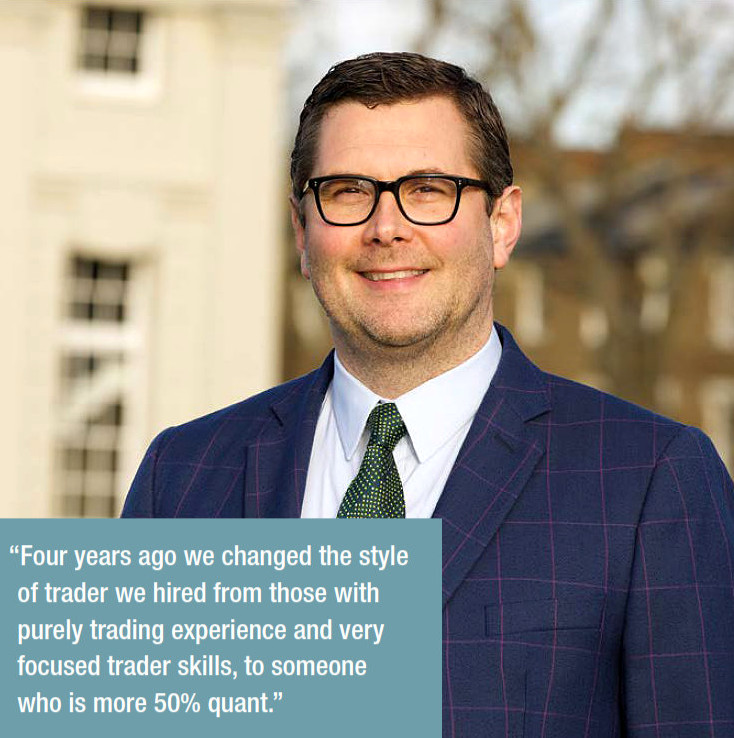 Four years ago we changed the style of trader we hired from those with purely trading experience and very focussed trader skills, to someone who is more 50% quant in skill set. We are not quant traders, but we are quant in our use of data. The sheer volume of data has gone up, as widely predicted, as a result of electronification and also due to the different sources of liquidity that have become available. There is more data than humans can handle. You need to be able to manipulate that data into a consumable format so that you can make decisions.
Four years ago we changed the style of trader we hired from those with purely trading experience and very focussed trader skills, to someone who is more 50% quant in skill set. We are not quant traders, but we are quant in our use of data. The sheer volume of data has gone up, as widely predicted, as a result of electronification and also due to the different sources of liquidity that have become available. There is more data than humans can handle. You need to be able to manipulate that data into a consumable format so that you can make decisions.
Within the traders we have degrees of specialisation because some of the markets have very different styles, such as corporate credit, sovereign and FX, and because they are very different beasts in terms behaviour, the time it takes to execute a trade, and the prioritisation of importance. Price is always a factor. Liquidity can be a more dominant factor depending upon what you want to achieve with a specific trade block. The reality is you need a degree of specialisation in product.
What sort of investment outcomes are you typically looking for?
We have different styles: yield targeting funds; buy and hold; we have funds for trading. So style-wise we have them all. The trading desk’s goal is always to contribute alpha to each and every fund. We have that in our goals and objectives as a group for the year, we are fully part of the investment process. Traders have a trade idea generation sheet that they have designed which take in curve factors, and relative value factors, either based on peer groups that they discuss with the analysts, or have their own views on treasuries or other factors that can be an input. They present those to the portfolio managers and analysts on a weekly basis. That’s a big difference we have to the pure execution-style desk.
Which systems do you use?
Pre-trade we use Katana. It is interesting in its use of historical regression to identify opportunities for normalisation. It does generate some useful ideas and is an interesting proposition at the price point that it has started at. From my side, that’s a fintech solution that we couldn’t produce easily in-house. Because of the 50 per cent quant element that our traders have, they can take a lot of data into R [statistical software] and they produce a lot of analysis themselves. There are other fintech solutions coming, but either the cost has been prohibitive, or they are haven’t been quite what we are looking for.
For ‘at-trade’ support, our order management system (OMS) is Bloomberg TSOX and from a connectivity point of view that’s fine. It’s a global solution, and when we are adopting technologies we must ask if it suits the global platform of trading that we have. It’s not sensible, from an IT support perspective, if we all start picking different systems. There is product specialisation; what you need to set up and have available for EM will be different from a US investment grade desk, or a treasury desk.
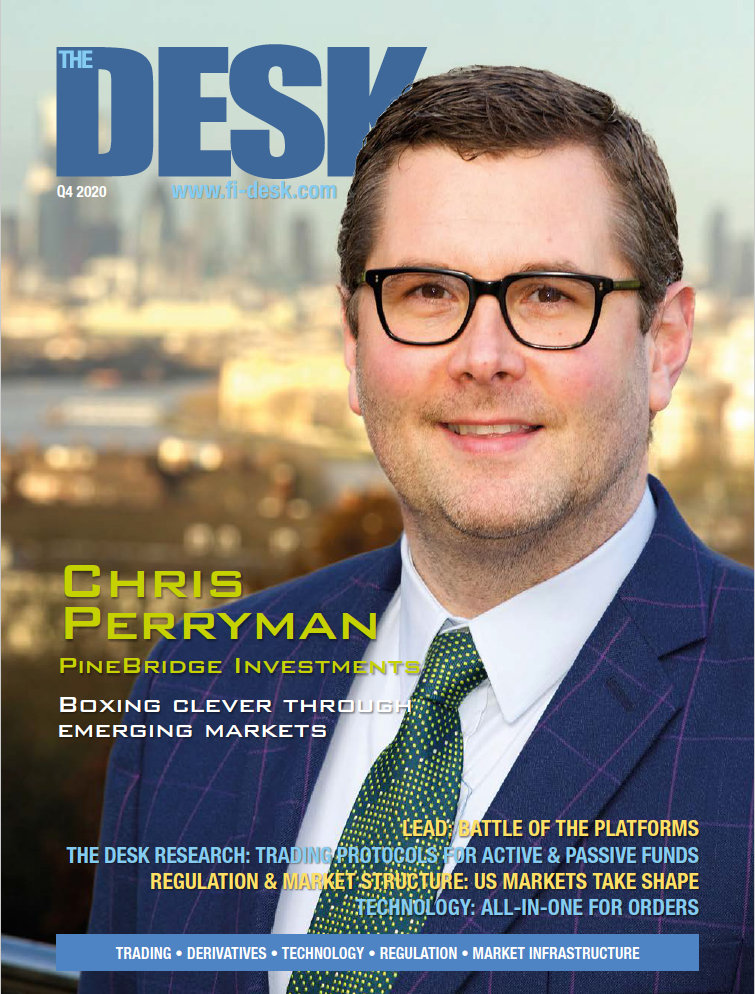 Dark pools [such as Liquidnet], have been better for trading liquid off-the-run bonds than they have for trading EM bonds. I think [with EM] there is still such a gap in pricing visibility that people are not prepared to trade at a price that would be reasonable to both, they still skew it towards themselves. So, if you are playing with a two-point bid/offer they will be very far left or right of that, rather than looking at trading at a mid-market to genuinely reduce costs for all. Understanding that skew according to whether the market is very bid or very offered is still grey. So volumes going through are not particularly great for EM, but in European credit we found this year it has been very interesting; where there is a very narrow bid/offer people are a bit more sensible around trading. Therefore dark pools are useful for trading blocks and we have seen greater frequency of those trades.
Dark pools [such as Liquidnet], have been better for trading liquid off-the-run bonds than they have for trading EM bonds. I think [with EM] there is still such a gap in pricing visibility that people are not prepared to trade at a price that would be reasonable to both, they still skew it towards themselves. So, if you are playing with a two-point bid/offer they will be very far left or right of that, rather than looking at trading at a mid-market to genuinely reduce costs for all. Understanding that skew according to whether the market is very bid or very offered is still grey. So volumes going through are not particularly great for EM, but in European credit we found this year it has been very interesting; where there is a very narrow bid/offer people are a bit more sensible around trading. Therefore dark pools are useful for trading blocks and we have seen greater frequency of those trades.
How does your trading break down into low touch and high touch proportionately, and are you using any automation?
Technically all of our trades are electronic. Probably between 30-40 per cent are purely electronic low-touch and the rest are block traded, negotiated, and then electronically completed. In certain markets, our size is simply not electronic friendly. The EM space still has some way to go before it’s natural to trade US$10 million+ blocks of corporate bonds so there is always going to be negotiation. We have looked at automation, we have come close to doing it, but we are still working on better understanding how circuit breakers work when people are off the desk. So we haven’t adopted automation fully, but we are looking to because where does the trader add value in a German bund trade or a US treasury trade? The point of execution there is really speed, there is no value-add.
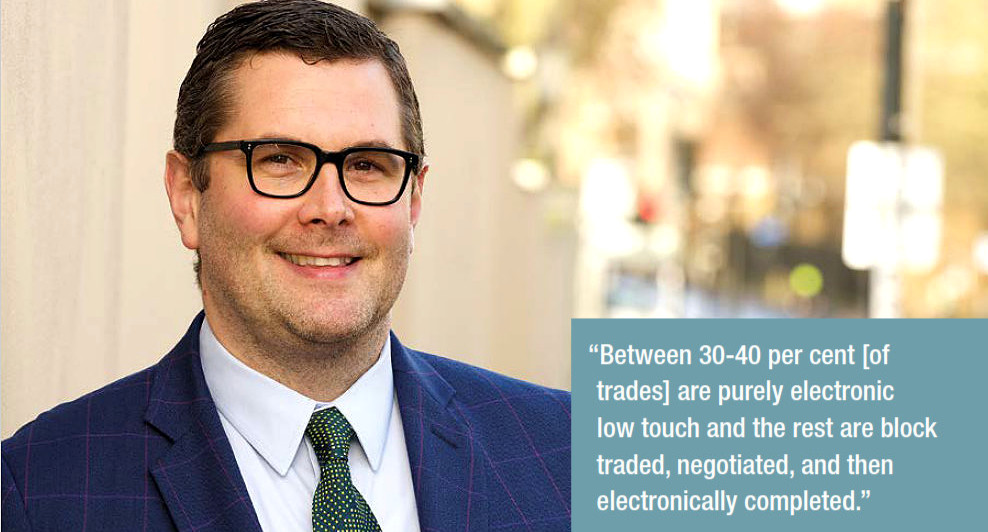
We are trying to innovate in pre-trade, and as I say for me the last time we looked at the various systems that have a degree of automation, there is just a question mark for us over the circuit breaker.
We might want a rule that movement of 10 per cent outside of market trading would shut [a trade] down, but that still requires manual intervention today. If it is automated, it should be fully automated with a good circuit breaker; it doesn’t count as automation if someone is still looking at it.
Presumably then, you see both high and low touch as part of the same trading process, rather than being separate desks?
Yes, everyone saw that this year. Even treasury markets didn’t trade electronically for a period. There is a point when someone has to intervene, decide to turn systems off and trade manually. A person needs look at a blotter and say, ‘This would suit automation, and this would not’ and that breadth of experience is good. I don’t need a separate low touch trading desk, because some days it’s low touch, other days it’s high touch. Separation creates this no-mans’-land of expertise and that’s a problem for me.
How would you characterise the difference between trading EM debt versus developed market high yield and investment grade?
A developed market is a pure spread product in credit terms, and it trades like that. Therefore, you focus on two factors for checking your price points; the spread and the underlying government bonds. Bridging that trade together takes a different timeframe to EM. There are aspects of the price that you need to understand. EM trading is still very much priced, with a hint of a spreads model. It’s also very niche, no bank globally offers everything.
In the EM the key is really understanding and having local and international banks available for liquidity. The other difference is the ownership structure. In Asia up to 80 per cent of debt will be owned by locals so you need local knowledge to understand where it is. In Europe you will find it’s mostly distributed to large institutional investors so you are less tied to a country-specific style of trading.
That’s also true in Latin America and Middle East; you see some pockets like Colombia and Chile where the pension fund rules require them to buy dollar debt that’s related to their country. Understanding those rules, the movement of pension flows, especially in last year where COVID has allowed people to have access to pensions onshore, allow you to ask if that might mean there is going to be a wave of selling in the dollar market. Does that create a different liquidity source for us? Do we have people tapped into that liquidity? Because the local pension funds don’t always trade through international banks, they may just trade with a local bank. Degrees of separation mean we can be tapped into that information on the ground. I would say that is the biggest difference; information flows are more bifurcated, and finding it is more niche.
Which of the markets you trade are most interesting – and challenging?
The biggest and most interesting market this year, which has opened more broadly, is China. We’ve had to advise clients on which protocols to use and what would suit them best. I think there are some advantages and disadvantages in both styles of access in the local market [via qualified status or through the Bond Connect platform] so structure-wise that’s a really interesting market to understand as it has opened up to foreigners. Sub-Saharan Africa in dollar markets are seeing more issuance; with worries around COVID and noise around that market liquidity has swung both ways, but it’s always like that in Sub-Saharan Africa. If you don’t understand that it’s a painful experience to trade. Stylistically that’s a different market in the sovereign space.
The most interesting corporate markets to trade have been high yield; sectors that were very specifically COVID-affected like the airline sector saw a very different number of counterparties prepared to trade it. That understanding of liquidity, of who provides liquidity on a regular basis, and who trades occasionally becomes really important. Some bonds will have three people that trade them in the world; others will have 20 people, very regularly. We need to know that market, the dealers, what they hold, their ratio of trading with us, and understand their liquidity provision.
What do you make of the electronic markets moving into the EM space?
MarketAxess is quite useful if you want to trade net dollars, i.e. embed the FX. With some other platforms we have had some specific regional issues with sign offs from certain areas. Some platforms haven’t got a country specifically signed off with China. For example, Canada wasn’t signed off for a period of time with different regions, which can affect our ability to trade for the end client on a specific platform.
An interesting element of Brexit has been understanding counterparties you face, where you will be allowed to face them, how you are going to put those trades through. That discussion is fairly limited for us, but we have made sure that we kept ties with all the counterparties and can access those through a platform correctly, and make sure it’s correctly mapped. That’s been one of the main things that we have worked on recently. A lot of people have put big leaps on hold this year because they don’t want to introduce business risks this year.
Has your use of trading protocols changed?
Not really; maybe because the bulk of our business is corporate. We have access to firms that unbundle exchange traded funds (ETFs) and look for specific liquidity in bonds in a specific timeframe. That gives some advantages in providing liquidity at that time, so we get a better price. That was very interesting in the March to May period where the ETFs were having daily liquidity needs that weren’t being met, and then started trading at a discount. From our side that was an interesting period, making sure we had visibility on those types of platforms or venues for liquidity. We had that set up and it was good to have in that period.
This year we had confirmation that we have got our fingers in the right pies for liquidity. The degree of change within those opportunity sets has been fairly marked, depending on the tone of the market and its risk profile.
Presumably you keep a massive dealer list compared to most other firms?
With EM it’s about understanding local and niche players. We have a risk committee that looks at, and credit checks, all of the banks and counterparties we trade with. The way we add counterparties is to monitor them and have a relationship with them prior to trading. We effectively measure their price against where we were getting liquidity. If there is a point in time where we notice they are markedly better or showing signs that they would be in the mix with a reasonable number of hits, that’s when we look to add a counterparty. Our list is mixed deliberately with local and international because of the swings in the nature of liquidity. Locals tend to be consistently there, but also tend to become directional at periods of time.
How do ‘EM tourists’ mix things up?
They can create either positive or negative experiences depending on what side of the trade you want to be. You get situations where people perceive platform liquidity to be deeper than they realise, but once the information is out the noise is there and price changes in EM can be fairly material, and move very quickly. This year we were able to take advantage of that largely because our end clients were happy to stay in EM and actually add.
So we have seen inflows at a perfect time in terms of market noise. We were able to match off with that risk, so this year I would say tourists in the market have been very beneficial and helpful. Their impact over time is getting squeezed out. A local guy based in China who owns China risk is not going to care if an Argentine sovereign defaults or if a company in Brazil is in trouble. We have seen that idiosyncratic stories don’t spread. When I started EM was very much traded ‘risk on/risk off’.
Typically the impact now is one or two days of a specific flow. The recent China sanction is a good example of that; US guys have had to exit, the China guys are happy to buy. Maybe US$1 to US$2 billion in credit flow went from the US across to the China side. There has been a price move obviously, but it’s started to creep back as that excess supply is being absorbed. That’s the change in style of EM that’s happened over the last four to five years.
Is direct dealer streaming useful for you?
We are still in a relationship business, especially in primary markets – they are not electronified in any way although there are moves to make it so. Access to pools of liquidity are still relationship-based in EM in size. Non-conventional dealers are becoming reasonable in size so they appear on our radar more. They are a good alternative source of liquidity because sometimes their price motivation for trading is different because they have a set timeline. For us that creates an interesting opportunity. With direct dealer streaming, from our side price information is always useful. So, if we are seeing clearing levels for auctions, or we are seeing more colour around a specific price point in risk, it helps us create and paint a better picture.
What sort of values do you think traders should have?
I have set up our desk to focus on contributions to the investment process. We want to hire someone who has an appetite to be a finance professional for a long period of time, to grow, learn and develop skills that are pre-trade, alpha generative. Openness to learn and willingness to embrace new innovations around quant and the more traditional skills.
Are gaps appearing between generations of traders?
Yes, I would say so. We’ve hired a trader to start in January and we went the grad route because we felt the skill set is teachable, and the openness to learn was better placed there. The trader 2.0 is a mix, they have to have programming skills because the data sets are so large in all areas, and the expectation to model and understand risk for the end clients is becoming more sophisticated.
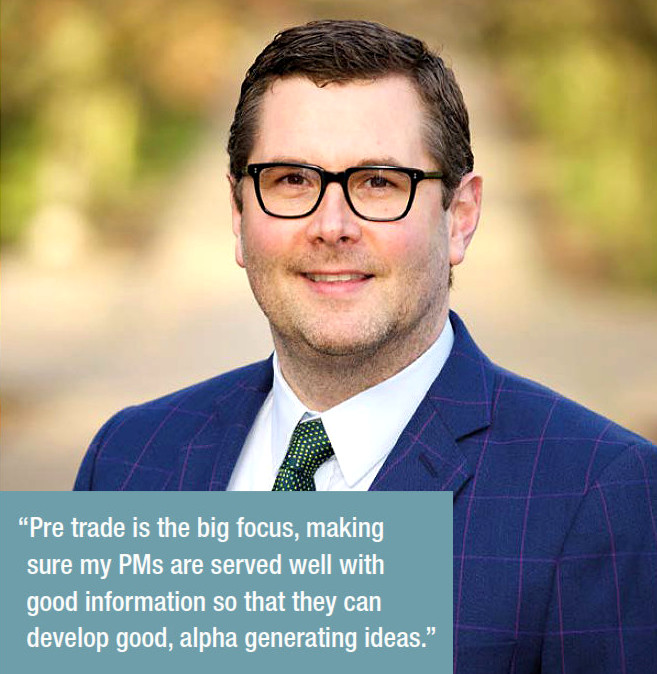 What are your targets for the next 18 months and where will you invest time and money?
What are your targets for the next 18 months and where will you invest time and money?
Pre trade is the big focus, making sure my PMs are served well with good information so that they can develop good, alpha generating ideas. We achieve that not just by acquiring data, but getting the data to a point where it creates and generates the idea. We are more obsessed with what to do with data than hoarding it.
More consolidation in-house would be broadly beneficial in terms of cost and scale. Where we are going to spend money in 2021 is probably also pre-trade.
©TheDESK 2020
©Markets Media Europe 2025



